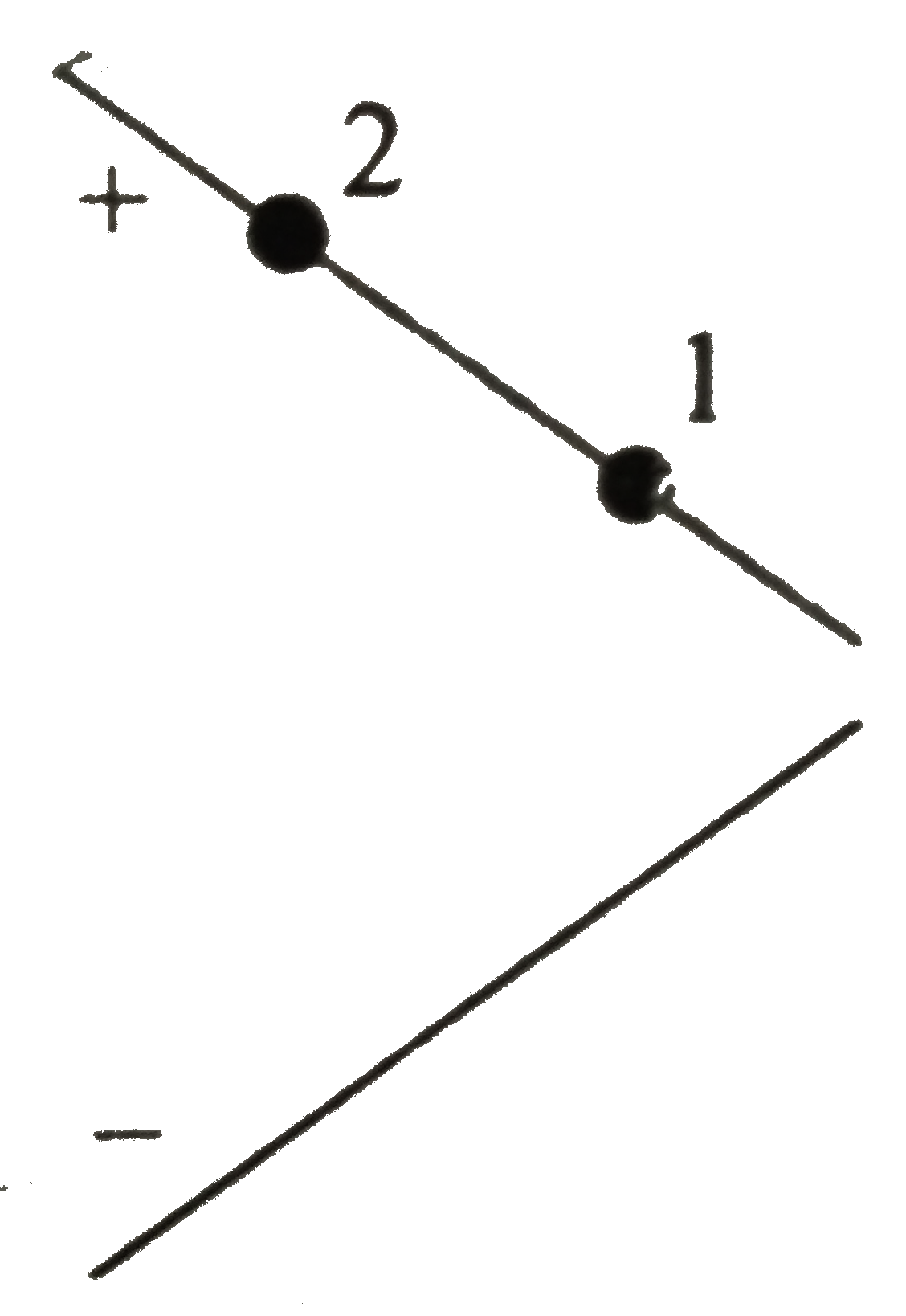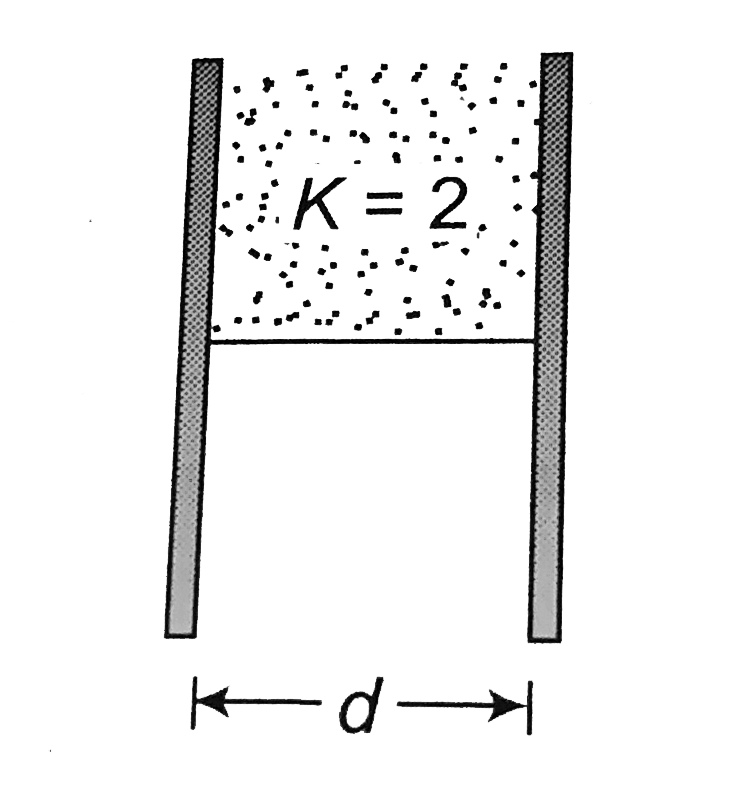A parallel plate air capacitor has initial capacitance C. If plate separation is slowly increased from d1 to d2, then mark the correct statement (s). (Take potential of the capacitor to be constant, i.e. throughout the process it remains connected to battery.)
Work done by electric force=negative of work done by external agent.
Work done by external force=−∫→F.→dx, where →F is the electric force of attraction between the plates at plate setaration x.
Work done by electric force ≠negative of work done by external agent.
Work done by battery = two times the change in electric potential energy stored in capacitor.
The correct Answer is:A, B, D
C=ε0Ad1,C'=ε0Ad2
Extra charge flown =Q'=Q(C'−C)V
=ε0AV[1d2−1d1]
Work done by battery is
Wb=V×charge flown=ε0AV2[1d2−1d1]
Change in potential energy of capacitor is
ΔU=12(C'−C)V2
=12ε0AV2[1d2−1d1].
Topper's Solved these Questions
- BOOK - CENGAGE PHYSICSCHAPTER - CAPACITOR AND CAPACITANCEEXERCISE - Comprhension35videos
CAPACITOR AND CAPACITANCE
- BOOK - CENGAGE PHYSICSCHAPTER - CAPACITOR AND CAPACITANCEEXERCISE - Integer5videos
CAPACITOR AND CAPACITANCE
- BOOK - CENGAGE PHYSICSCHAPTER - CAPACITOR AND CAPACITANCEEXERCISE - Single Correct49videos
CAPACITOR AND CAPACITANCE
- BOOK - CENGAGE PHYSICSCHAPTER - ATOMSEXERCISE - QUESTION BANK40videos
ATOMS
- BOOK - CENGAGE PHYSICSCHAPTER - CENGAGE PHYSICS DPPEXERCISE - subjective type51videos
CENGAGE PHYSICS DPP
Similar Questions
A parallel plate air capacitor is connected to a battery. If the plates of the capacitor are pulled farther apart, then state whether the following statements are true or false.
a. Strength of the electric field inside the capacitor remains unchanged, if the battery is disconnected before pulling the plates.
b. During the process, work is done by the external force applied to pull the plates irrespective of whether the battery is disconnected or not.
c. Strain energy in the capacitor decreases if the battery remains connected.
 .View Solution
.View SolutionAN air filled parallel plate capacitor has a capacitance of 2.1 pF. The separation of the plates is doubled, and wax is inserted between them . The new capacitance is 2.6pF Find the dielectric constant of the wax.
View Solution
Knowledge Check
- Question 1 - Select One
A parallel plate air capacitor has a capacitance C. When it is half filled with a dielectric (K=2), the percentage increase in the cpacitance will be
 A25%B50%C75%D100%
A25%B50%C75%D100% - Question 2 - Select One or More
A parallel plate air capacitor is connected to a battery. If plates of the capacitor are pulled farther apart, then which of the following statements is/are correct ?
AStrength of electric field inside the capacitor remains unchanged, if battery is disconnected before pulling the plateBDuring the process, work is done by external force applied to pull the plates either battery is disconnected or it remains connectedCStored energy in the capacitor decreases if the battery remains connectedDNone of these - Question 3 - Select One
A parallel plate capacitor of area ‘A’ plate separation ‘d’ is filled with two dielectrics as shown. What is the capacitance of the arrangement ?
 A3Kε0A4dB4Kε0A3dC(K+1)ε0A2dDK(K+3)ε0A2(K+1)d
A3Kε0A4dB4Kε0A3dC(K+1)ε0A2dDK(K+3)ε0A2(K+1)d
A parallel plate capacitor has a capacitance of 6μF. If the separation between the plates is reduced to one half of its original separation and a dielectric of dielectric constant 3 is introduced between the plates of capacitor, its new capacitance will be __________ .
View SolutionA parallel plate air capacitor has a capacitance C. When it is half filled with a dielectric of dielectric constant 5, then the percentage increase in the capacitance will be
 View Solution
View SolutionA parallel plate air capacitor has a capacitance C. When it is half filled with a dielectric of dielectric constant 5, the percentage increase in the capacitance will be
View SolutionA parallel plate capacitor has the space between its plates filled by two slabs of thickness d2 each and dielectric constant K1 and K2. d is the plate separation of the capacitor. The capacitance of the capacitor is
View SolutionA parallel plate capacitor with air between plates (dielectric constant K =2) has a capacitance C. If the air is removed, then capacitance of the capacitor is
View Solution
